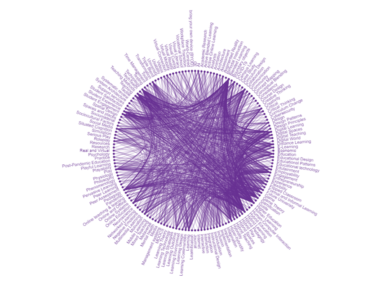Video provides an increasingly popular alternative for academics to deliver their presentation at an international conference. However, video still being a new format, neither presenters and audiences are completely familiar with it. It requires some experimentation to find out what good formats are, say the experts.
More and more academic conferences are opening up the possibility for presentations via video instead of physical participation. Enabled by increasingly user-friendly technology and triggered by environmental concerns, conference organisers embed special streams in their programmes dedicated to video sessions. The coronavirus outbreak is expected to encourage researchers even more powerfully to switch from onsite to virtual conference participation.
For example, last year the International Association for Media and Communication Research conference IAMCR held in Madrid launched an “experimental initiative” to call for video presentations. Five working groups and sections accepted presentations in video format, resulting in the acceptance of eleven video presentations total for the entire conference. The practice is continued at this year’s conference, which was transferred from China to Finland, with a joint call by seven sections and working groups.
The video presentation possibility was not only opted for to “provide alternatives to address the environmental impact”, as expressed in the call, but also to counteract exclusions that conferences typically have. For example, scholars from developing nations and doctoral students have fewer possibilities to participate and cover travel and participation fees. Video presenters are required to pay only half of the conference registration fee.
First video, then video call
Even if the technology is easily available, questions remain about the format and about the practical decisions that need to be made.
Browsing through slides may be slightly boring – even in the instructions presenters are often requested to avoid a “talking heads video”.
Most conference organisers suggest a screen-recorded video showing a slide set, with the researcher’s voice-over. These types of videos are made with a screen recording tool often included in the licences provided by universities; for example, Camtasia. However, there are a number of alternatives available. One possibility is to make a recorded Zoom session, which compares with a recording of a webinar presentation, yet without any online interaction with participants.
Another possibility is to record a presentation in a classroom or a video conferencing room, showing the presenter. Video presentation instructions recommend framing the speaker above the shoulders and recording with the camera aligned with the eyes. The camera can be put on a tripod or operated by a colleague, but the video can even be made with a mobile device. To increase clarity, providing subtitles in the video is also requested.
The maximum duration of presentations in current calls varies from twelve minutes. After the video presentation screening, presenters are required to be available on Skype or an alternative communication channel endorsed by the session organisers – for example, Zoom, Facetime, WhatsApp call, Facebook Messenger Call – to answer questions in a way similar to conventional onsite presentations.
Creative possibilities
On their webpage, the IAMCR organisers say they “believe that we should also acknowledge and stimulate the creative opportunities that video presentations can offer to conference presenters”. But what exactly are those creative opportunities?
Tonny Krijnen, head of the Popular Culture working group at the IAMCR, says that they received three video submissions, showing different degrees of creativity.
“All three were interesting and tremendously different in shape. One was supported by a local university’s technical support which made it engaging, and of very high quality. It was a mix of numbers and stats, and visual material, showing a TV clip”, she explains.
“The second one consisted of lots of supporting visuals to the argument of a presenter not being able to present. The argument was highly theoretical and the visuals really contributed to its comprehensiveness and strength. The author used her voice as narrator in the video, giving the audience a chance to engage with her thoughts in-depth – more in-depth than a traditional presentation could have done.”
Prof. Marco A. Janssen, President of the International Association for the Study of the Commons, has experience from organising an entirely virtual conference in 2018, with 40 video presentations and 100 participants. There will be another coming up this year. Prof. Janssen says that despite the many inspiring possibilities available, many of presenters still opt for the talking head presentation.
“One of the challenges related to video presentations is that it is a new format and not everyone is familiar with it. It requires some experimentation to find out what good formats are”, Prof. Janssen says.
Preparation is the key
Anna Sundermann, a research fellow at the Leuphana University of Lüneburg in Germany, held a video presentation in the Environment, Science and Risk Communication Working Group (ESR) at the IAMCR2019 conference with two colleagues, one of them located in Arizona in the US.
“I chose a voice-over video presentation with an embedded video link because I could easily prepare it on my own, and it was time-efficient and at low cost. Next time, I would like to try other forms, with support of the media centre at my university, but it requires more time”, she says.
She thinks that video presentations are a good opportunity to make others aware of your research in an entertaining manner while the manuscript is still being prepared.
“The first steps of the preparations were the same as if I had given a normal presentation. However, I had to do everything on time, and as it was my first time, it took a long time for the text being recorded without mistakes. At last, it felt good to be completely prepared three weeks before the conference and to be able to concentrate on the questions of the audience”, she explains.
Still, she realised that there are some disadvantages of not physically being at the conference location.
“The organisation should ensure that the session chairs are well prepared for video presentations. I could not really see how many people in the room were listening to my presentation because my camera did not point in the right direction. The questions were hard to understand as the microphone was not adjusted to the audience, the presenters and me in the virtual conference room. I did not have a good overview and had to wait a long time for my presentation without being able to understand or listen to the other presenters”, says Sundermann.
“Besides, there was a sudden breakdown during the presentation, so I could only see the floor and feet of the other presenters. My American colleague, who was online in the middle of the night, completely disappeared at some point. However, I understand that these are all problems of pioneering work.”
Sundermann thinks that the video presentations are still new to the audiences, as well, so not only the presenters and session presiders have to be prepared.
“It would be great if you could watch the videos throughout the conference and there would be a permanent blog or a similar site where questions could be sent to the video presenters”, she suggests.
Editor’s note: An earlier version of this article was published on NordMedia Network, a site for Nordic media and communication researchers run by Nordicom.

Author:
Maarit Jaakkola
Co-Director, Associate Professor
The Nordic Centre for Media Research NORDICOM
University of Gothenburg, Sweden














